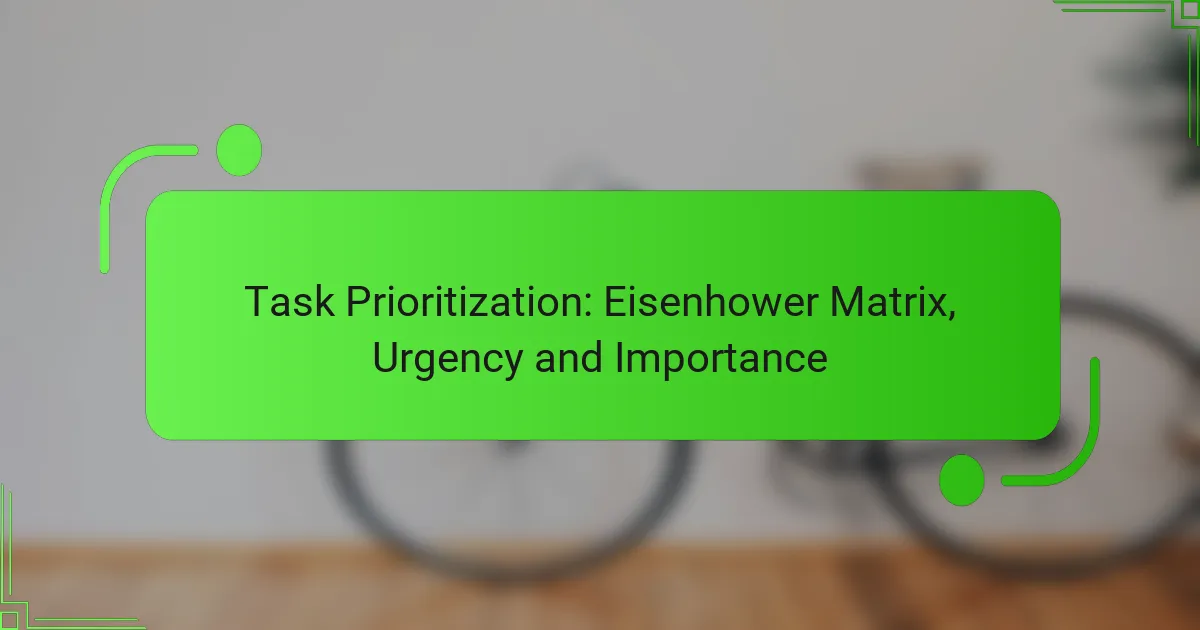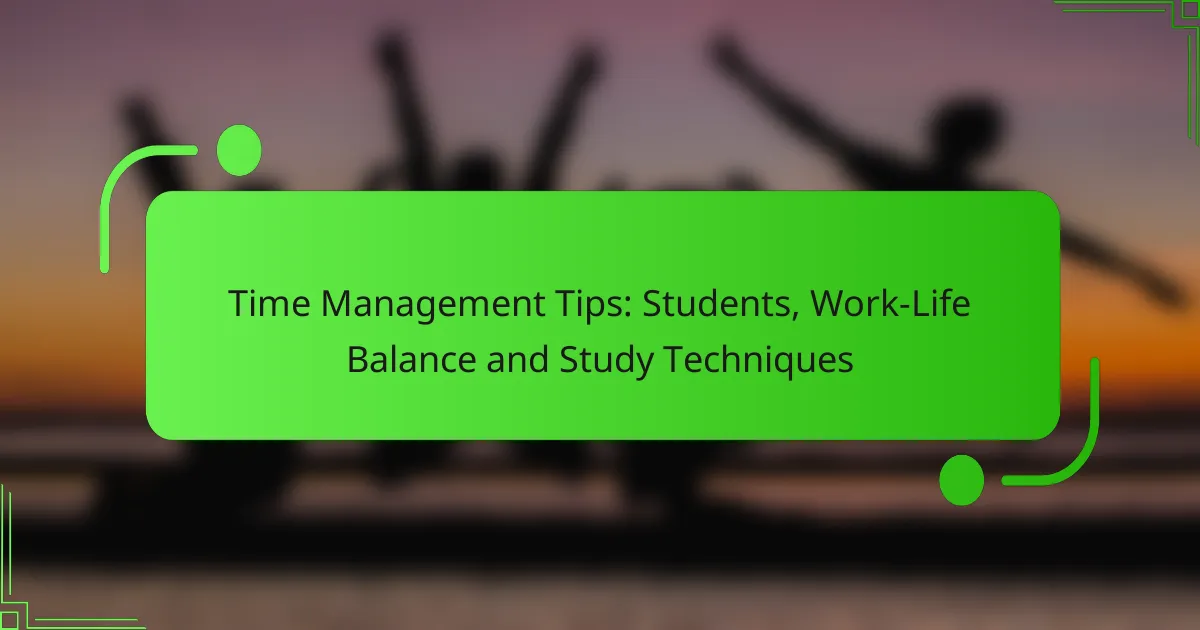The Eisenhower Matrix is a powerful tool for prioritizing tasks based on their urgency and importance. By categorizing tasks into four quadrants, you can make informed decisions about what to focus on, delegate, or eliminate, ultimately leading to better time management and enhanced productivity.
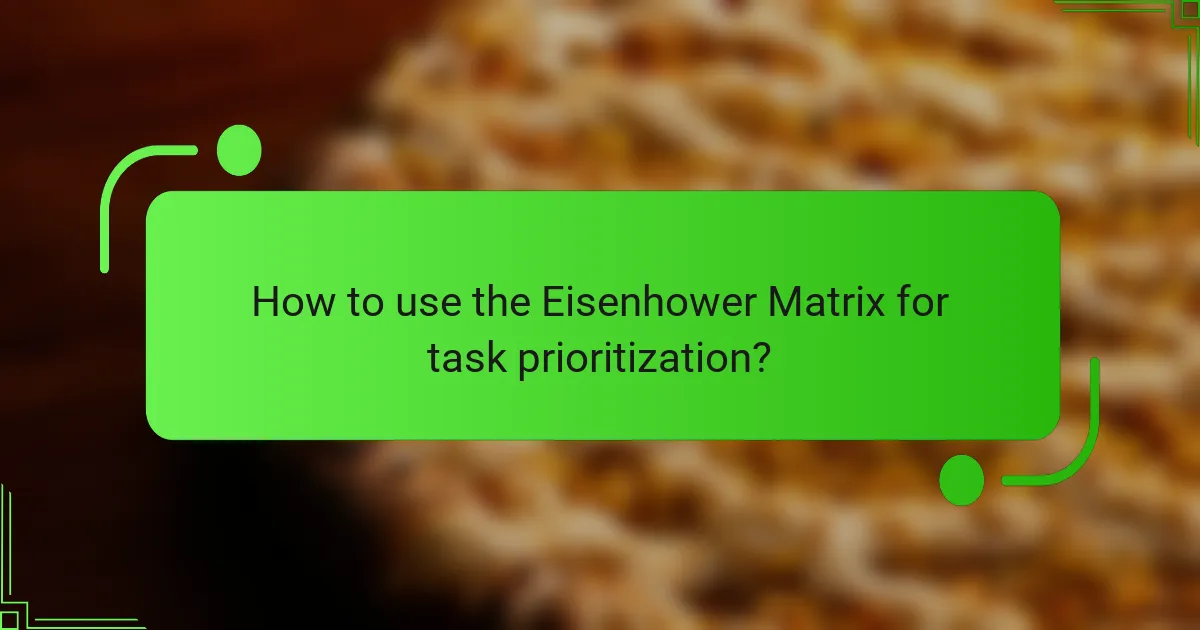
How to use the Eisenhower Matrix for task prioritization?
The Eisenhower Matrix is a powerful tool for prioritizing tasks based on their urgency and importance. By categorizing tasks into four quadrants, you can make informed decisions about what to focus on, delegate, or eliminate.
Quadrant one: Urgent and Important tasks
Tasks in this quadrant require immediate attention and are critical to achieving your goals. These might include project deadlines, crisis management, or urgent client requests. Prioritizing these tasks ensures that you address pressing issues that could impact your success.
To manage these tasks effectively, consider creating a daily to-do list that highlights these urgent and important items. Focus on completing them first to maintain momentum and reduce stress.
Quadrant two: Important but Not Urgent tasks
These tasks are essential for long-term success but do not require immediate action. Examples include strategic planning, skill development, and relationship building. Allocating time for these tasks can lead to significant benefits over time.
Schedule regular time blocks in your calendar to work on these important tasks. This proactive approach helps prevent them from becoming urgent and ensures steady progress toward your goals.
Quadrant three: Urgent but Not Important tasks
Tasks in this category demand immediate attention but do not contribute significantly to your long-term objectives. Common examples include certain emails, phone calls, or meetings. While they may feel pressing, they can often be delegated or postponed.
To handle these tasks efficiently, consider delegating them to others or setting specific times to address them. This strategy frees up your time for more important activities.
Quadrant four: Not Urgent and Not Important tasks
These tasks are neither urgent nor important and often serve as distractions. Examples include excessive social media browsing or unproductive meetings. Identifying and minimizing these activities can enhance your overall productivity.
Evaluate how much time you spend on these tasks and aim to eliminate or reduce them significantly. This will allow you to focus on more meaningful work that aligns with your goals.
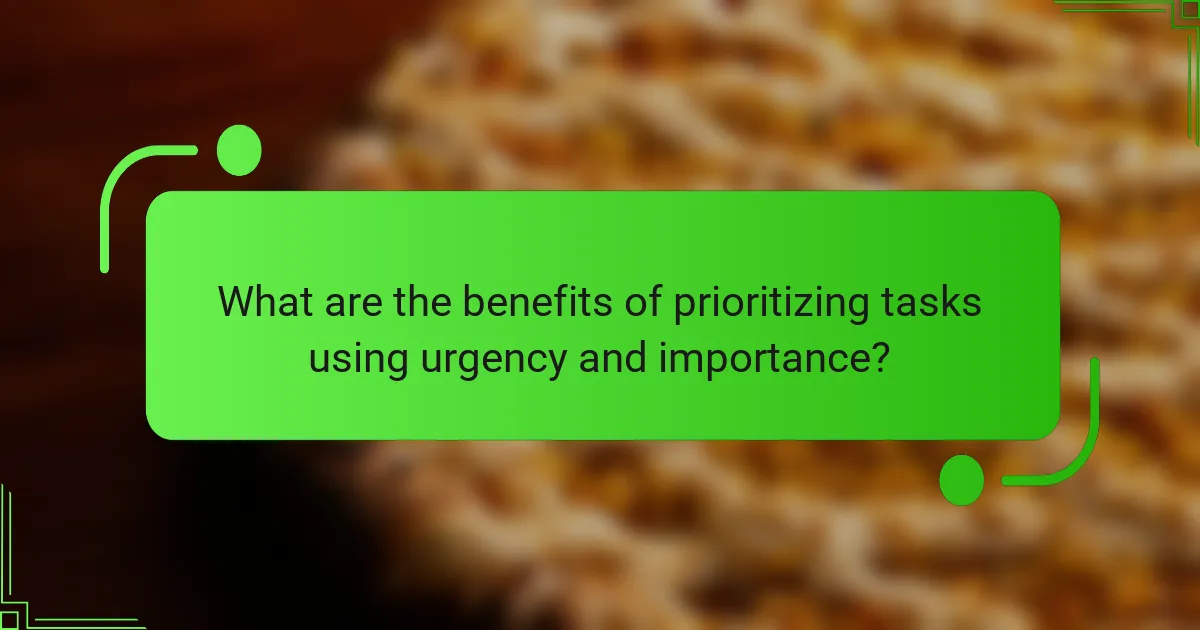
What are the benefits of prioritizing tasks using urgency and importance?
Prioritizing tasks by urgency and importance helps individuals focus on what truly matters, leading to better time management and efficiency. This method, often visualized through the Eisenhower Matrix, allows for clearer decision-making and enhances overall productivity.
Improved productivity and focus
Using urgency and importance to prioritize tasks can significantly boost productivity. By categorizing tasks, individuals can concentrate on high-priority items that yield the most significant results, minimizing time spent on less impactful activities.
A practical approach is to tackle tasks in the “urgent and important” quadrant first, followed by those that are “important but not urgent.” This method ensures that critical deadlines are met while also allowing time for strategic planning and long-term goals.
Reduced stress and overwhelm
Prioritizing tasks effectively can lead to reduced stress levels. When individuals know which tasks to focus on, they can avoid the anxiety of feeling overwhelmed by their workload. This clarity allows for a more manageable daily routine.
To further alleviate stress, consider breaking larger tasks into smaller, actionable steps. This makes daunting projects feel more achievable and provides a sense of accomplishment as each step is completed.
Enhanced decision-making skills
Utilizing urgency and importance in task prioritization sharpens decision-making skills. By regularly assessing tasks based on these criteria, individuals become more adept at identifying what requires immediate attention versus what can wait.
To enhance these skills, practice regularly using the Eisenhower Matrix. Over time, this will help develop a more intuitive sense of prioritization, allowing for quicker and more effective decisions in both personal and professional settings.
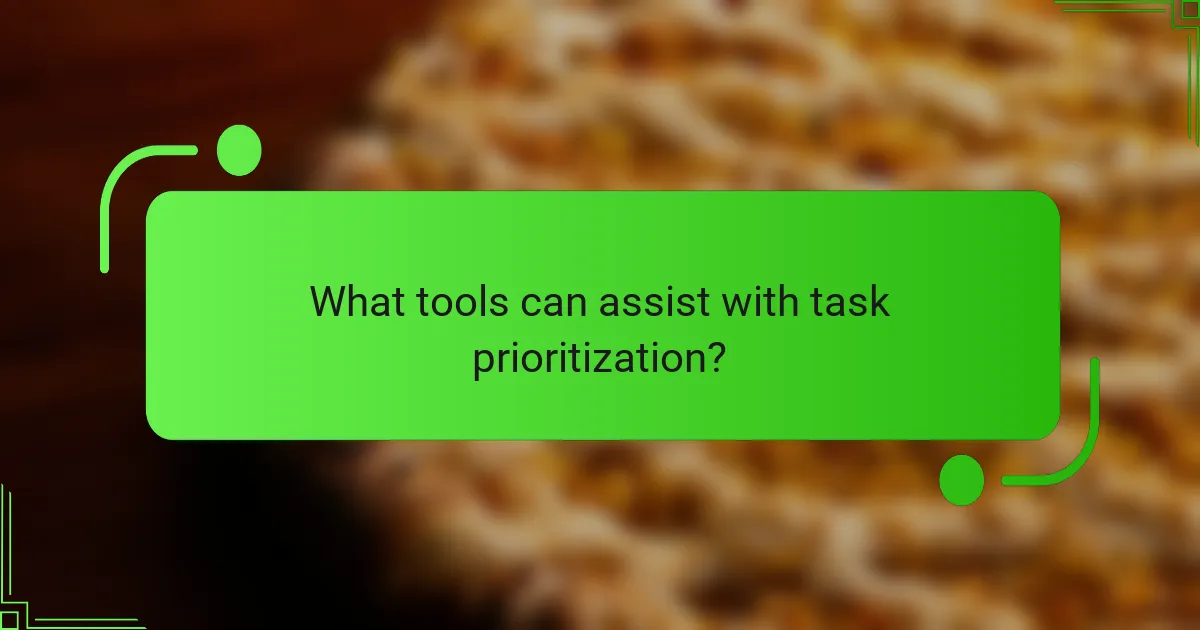
What tools can assist with task prioritization?
Several tools can enhance task prioritization by helping you visualize and manage your workload effectively. Popular options include Trello, Asana, and Todoist, each offering unique features tailored to different needs.
Trello for visual task management
Trello uses a card-based system to help users organize tasks visually. You can create boards for different projects, add lists for various stages of completion, and move cards between lists as tasks progress. This visual approach makes it easy to see what’s urgent and important at a glance.
To maximize Trello’s effectiveness, consider using labels and due dates to categorize tasks by urgency and importance. For example, you might label tasks as “High Priority” or “Low Priority” to quickly identify what needs immediate attention.
Asana for team collaboration
Asana is designed for team collaboration, allowing multiple users to assign and track tasks within projects. It offers features like timelines, calendars, and task dependencies, which help teams prioritize work based on deadlines and project goals.
To effectively use Asana for prioritization, establish clear project goals and deadlines. Regularly review tasks in team meetings to ensure everyone is aligned on priorities and adjust as needed to keep projects on track.
Todoist for personal task tracking
Todoist is a personal task management tool that helps individuals track their tasks and prioritize them effectively. It allows users to create projects, set deadlines, and assign priority levels to tasks, making it easier to focus on what matters most.
To get the most out of Todoist, use the priority feature to categorize tasks from P1 (highest priority) to P4 (lowest priority). This system helps you tackle the most critical tasks first, ensuring that urgent and important items are completed on time.
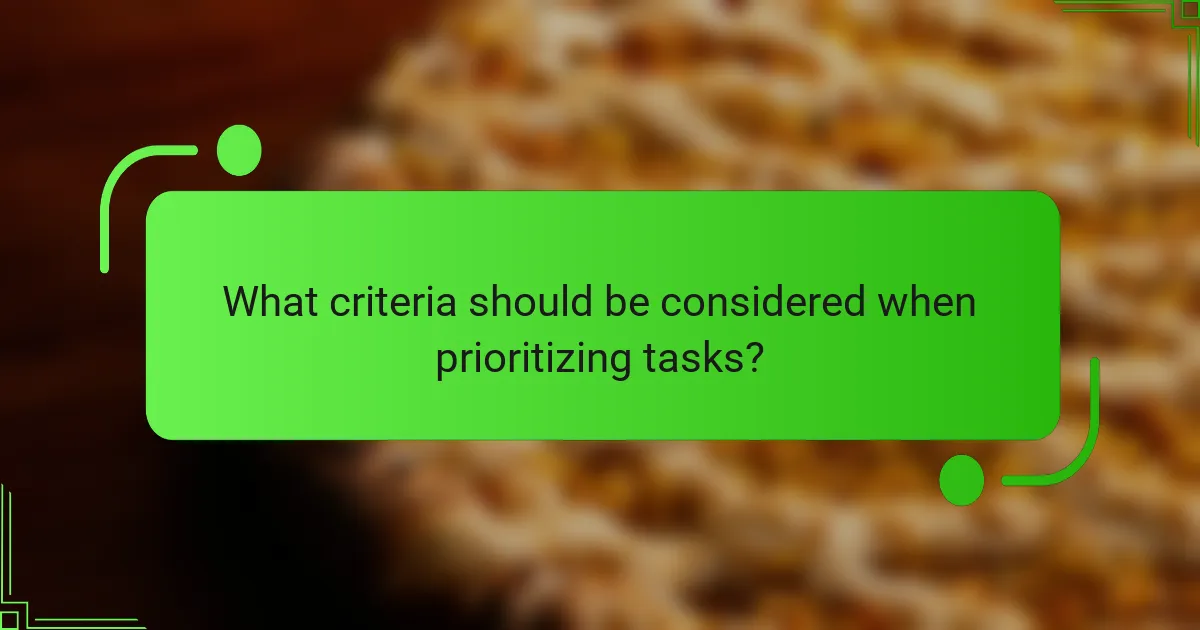
What criteria should be considered when prioritizing tasks?
When prioritizing tasks, consider factors such as deadline urgency, impact on goals, and resource availability. These criteria help you determine which tasks require immediate attention and which can be scheduled for later, ensuring efficient time management.
Deadline urgency
Deadline urgency refers to how soon a task needs to be completed. Tasks with imminent deadlines should be prioritized to avoid last-minute rushes and potential failures. For example, if a report is due tomorrow, it takes precedence over tasks with deadlines weeks away.
To assess urgency, categorize tasks into time frames: immediate (due today), short-term (due within a week), and long-term (due in a month or more). This helps in visualizing which tasks need your attention first.
Impact on goals
The impact on goals measures how a task contributes to your overall objectives. Tasks that align closely with your strategic goals should be prioritized higher, as they drive progress and success. For instance, completing a project that brings in significant revenue should take priority over routine administrative tasks.
Evaluate each task’s potential outcome by asking how it affects your short-term and long-term goals. A simple way to gauge this is to rank tasks based on their contribution to key performance indicators (KPIs) relevant to your objectives.
Resource availability
Resource availability considers the tools, time, and personnel needed to complete a task. If you lack the necessary resources for a high-priority task, it may be wise to defer it until those resources are accessible. For example, if a team member is unavailable, it might delay a collaborative project.
Assess your resources by creating a checklist of what is needed for each task. This can include budget, personnel, and technology. Tasks that require less resource investment can often be completed more quickly and should be considered for immediate action when resources are limited.
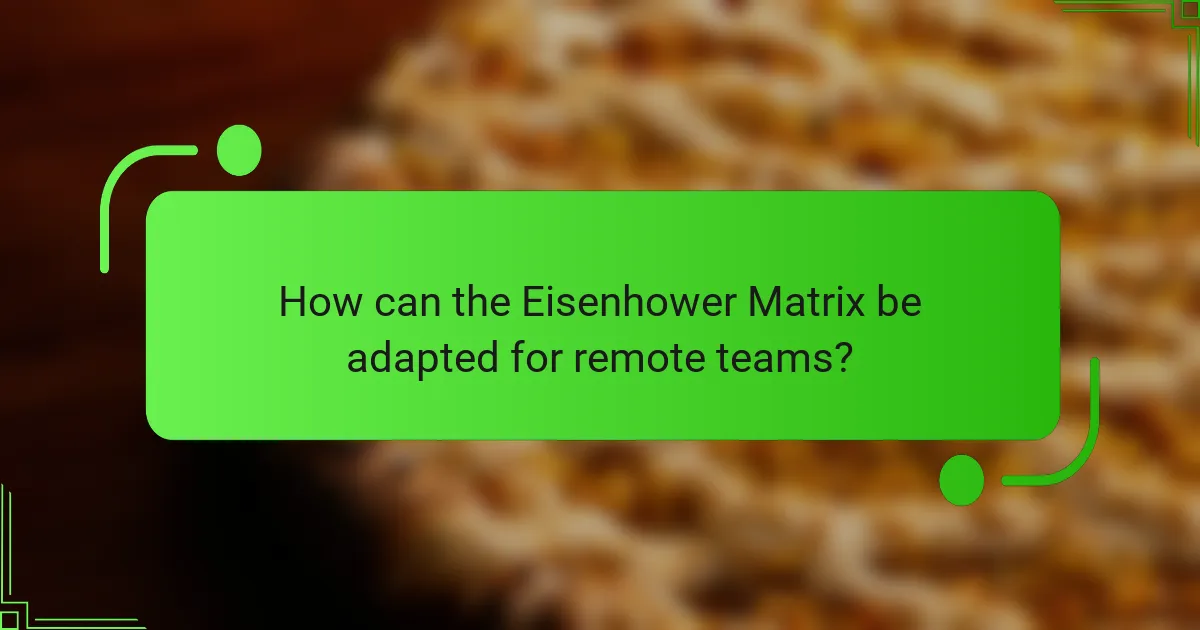
How can the Eisenhower Matrix be adapted for remote teams?
The Eisenhower Matrix can be effectively adapted for remote teams by leveraging digital tools and communication strategies that enhance clarity and collaboration. By categorizing tasks based on urgency and importance, remote teams can prioritize effectively, ensuring that everyone is aligned and focused on the right objectives.
Utilizing digital collaboration tools
Digital collaboration tools are essential for remote teams to implement the Eisenhower Matrix. Platforms like Trello, Asana, or Microsoft Teams allow team members to categorize tasks visually, making it easier to identify what is urgent and important. These tools often include features for tagging, deadlines, and progress tracking, which can help maintain accountability.
When using these tools, ensure that all team members are trained on how to use them effectively. Regular updates and clear labeling of tasks can prevent confusion and keep everyone on the same page.
Regular virtual check-ins
Regular virtual check-ins are vital for maintaining alignment within remote teams. Scheduling weekly or bi-weekly meetings can provide a platform for discussing priorities and adjusting the Eisenhower Matrix as needed. During these check-ins, team members can share updates on their tasks and re-evaluate what should be prioritized based on changing circumstances.
Consider using a structured agenda for these meetings to ensure that discussions remain focused on urgency and importance. This can help prevent meetings from becoming unproductive and ensure that all voices are heard.
Setting clear priorities in team meetings
Setting clear priorities during team meetings is crucial for effective task management. At the beginning of each meeting, review the current tasks categorized in the Eisenhower Matrix and identify which tasks need immediate attention. This practice helps to reinforce the importance of prioritization and keeps the team focused on high-impact activities.
Encourage team members to voice any challenges they face with their tasks, as this can lead to collaborative problem-solving. Additionally, consider creating a shared document that outlines the agreed-upon priorities, which can serve as a reference point for the team moving forward.
